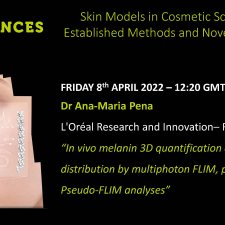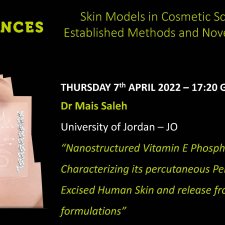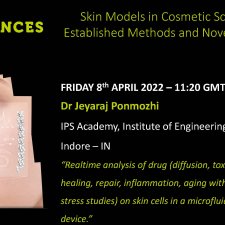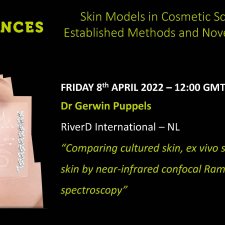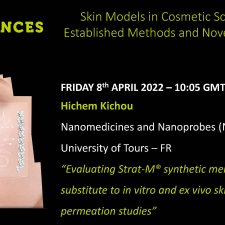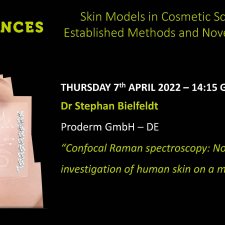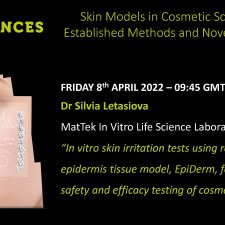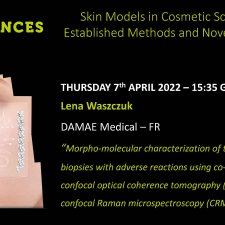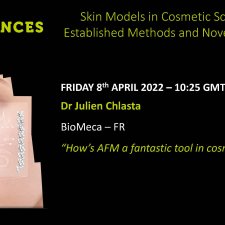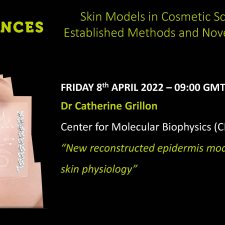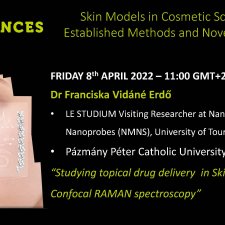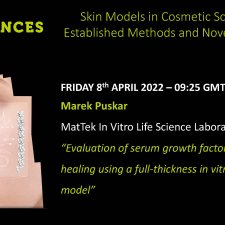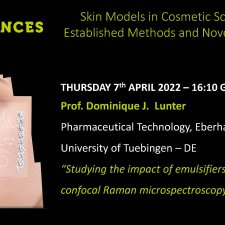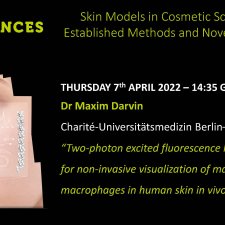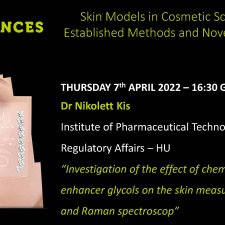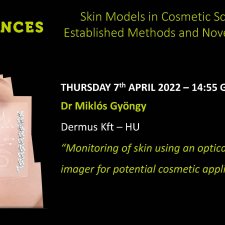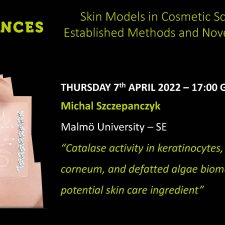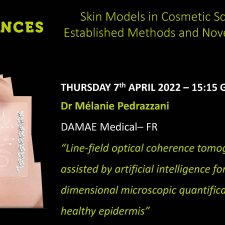Skin Models in Cosmetic Science: Bridging Established Methods and Novel Technologies 2nd meeting
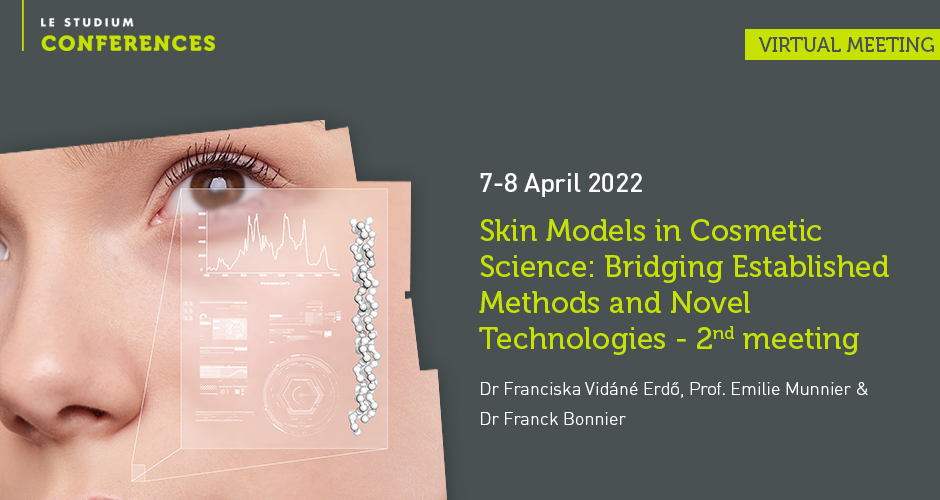
Descriptif
Following the successful 2019 edition of the International Interdisciplinary Conference titled “Skin Models in Cosmetic Science: Bridging Established Methods and Novel Technologies” held in Tours (France), the event is back for a 2nd edition. This event will take place as an online conference.
The conference aims to gather industry scientists and academics to discuss the state-of-the-art in the research and development of skin models and novel analytical techniques for efficacy and safety testing of cosmetic products. Cosmetic science is a buzzing field driven by constant innovation therefore testing, measuring, evaluating are essential to demonstrate innocuity and/or effectiveness of skincare products while durability and personalisation have become key market trends.
Talks and discussions will contrast various industrial and academic viewpoints and visions regarding the characterisation and evaluation of cosmetic products, particularly as these relate to the use of in vitro, ex vivo and in vivo models of human skin and recent progress in methodologies, technologies and instrumentation. Multi-techniques, multi-scales approaches, non-invasive and non-destructive analysis, hold promises for better characterisation of reconstructed skin models, studying physiological processes and visualise the effects of skincare products from bench top experiments to volunteers.
Sharing among researchers, suppliers, manufacturers, and other actors of the cosmetic industry is sought to provide a snapshot of latest scientific results and achievements but also to discuss current challenges to be addressed.
The region Centre-Val de Loire Regional Council actively supports the research and development in the field of cosmetic sciences. Held in the heart of the Cosmetic Valley technopole, the Conference is meant to promote national and international collaborations across industry and academia. Regional, national and international scientists in the field are strongly encouraged to attend and present their research. While a panel of renowned speakers will be invited, slots for oral presentations will be dedicated to rising scientists in the field to offer them a chance to present their work and to encourage their participation in the discussions.
The organising committee is very much looking forward to welcoming you.
This international conference is organised in the framework of the COSMETOSCIENCES ARD CVL Programme.
Vidéos
Dr Ana-Maria Pena - In vivo melanin 3D quantification and z-epidermal distribution by multiphoton …
Characterizing melanins in situ and determining their 3D z-epidermal distribution is paramount for understanding physiological /pathological processes of melanin neosynthesis, transfer, degradation or
Dr Mais Saleh - Nanostructured Vitamin E Phosphate: Characterizing its percutaneous Penetration int…
Modern topical sunscreens combine topical antioxidants with physical UV filters to achieve optimal skin protection1–3. α-Tocopherol phosphate (α-TP), a new pro-vitamin E antioxidant, prevents UVA1
Dr Jeyaraj Ponmozhi - Realtime analysis of drug (diffusion, toxicity, would healing, repair, inflam…
Advantages of microfluidics could outnumber the advantages in reconstructed and excised skin samples in certain cases for the study on permeability, toxicity, irritation, corrosion, disease models
Dr Gerwin Puppels - Comparing cultured skin, ex vivo skin, and in vivo skin by near-infrared confoc…
Skin cultures and ex vivo skin samples are increasingly used in tests of cosmetics and topical pharmaceutical products.
Hichem Kichou - Evaluating Strat-M® synthetic membrane as substitute to in vitro and ex vivo skin m…
Strat-M® is a multi-layered polymer membrane designed for transdermal diffusion testing without the need to account for human skin variability, safety and storage limitations.
Dr Stephan Bielfeldt - Confocal Raman spectroscopy: Noninvasive in vivo investigation of human skin…
For more than 20 years now confocal Raman spectroscopy is used to measure molecular concentration profiles in vivo in the human skin. With a depth resolution down to 3 µm the epidermis and upper
Dr Silvia Letasiova - In vitro skin irritation tests using reconctructed epidermis tissue model, Ep…
The EpiDerm 3D human tissue model is used across a diverse range of applications including safety and risk assessment, and biological efficacy. Simple protocols and the evaluation of early cellular
Lena Waszczuk - Morpho-molecular characterization of tattooed skin biopsies with adverse reactions …
Line-field confocal optical coherence tomography (LC-OCT) is a non-invasive optical technique for imaging the skin at high resolution (∼ 1 μm), based on a combination of OCT and reflectance confocal
Dr Julien Chlasta - How’s AFM a fantastic tool in cosmetic research?
Atomic force microscopy (AFM) is a tool for nanoscale analysis-based approach allowing to obtain mechanical information about structures
Dr Catherine Grillon - New reconstructed epidermis models closer to skin physiology
Among skin models, reconstructed human epidermis are largely used in cosmetic domain either to evaluate compounds activity or for regulatory tests such as toxicity. They represent a good alternative
Dr Franciska Erdo - Studying topical drug delivery in Skin-on-a-chip and by Confocal RAMAN spectros…
Studying skin composition and interaction with topical substances is important both in dermatology and cosmetoscience. Several techniques are utilized and are under development for these purposes.
Marek Puskar - Evaluation of serum growth factors in wound healing using a full-thickness in vitro …
Following skin injury, damaged tissue undergoes highly coordinated biological events to restore barrier function involving cross-talk between dermal fibroblasts and epidermal keratinocytes as well as
Prof. Dominique J. Lunter - Studying the impact of emulsifiers on SC lipids by confocal Raman micr…
Emulsifiers are widely used in face washes, shower gels, body lotions and many more cosmetic and pharmaceutic products. Some of them are suspected to show irritating effects and to harm the skin
Dr Maxim Darvin - Two-photon excited fluorescence lifetime imaging for non-invasive visualization …
Mast cells (MCs) and macrophages (ΜΦs) are important multifunctional immune cells found in all tissues of the body. In the skin, resting and activated MC populations and M1- and M2-polarized ΜΦs are
Dr Nikolett Kis - Investigation of the effect of chemical permeation enhancer glycols on the skin m…
Dermal drug delivery is an attractive alternative to conventional drug administration due to its advantages.
Dr Miklós Gyöngy - Monitoring of skin using an optical-ultrasound imager for potential cosmetic app…
Optical-ultrasound imaging is a cost-effective method of simultaneously imaging the skin surface and the region under the surface.
Michal Szczepanczyk - Catalase activity in keratinocytes, stratum corneum, and defatted algae bioma…
Catalase is one of the most important antioxidative enzymes. Its main function is the decomposition of hydrogen peroxide belonging to the group of reactive oxygen species.
Dr Mélanie Pedrazzani - Line-field optical coherence tomography (LC-OCT) assisted by artificial int…
Line-field confocal optical coherence tomography (LC-OCT) is an optical technique based on a combination of confocal microscopy and optical coherence tomography, allowing three-dimensional (3D)

